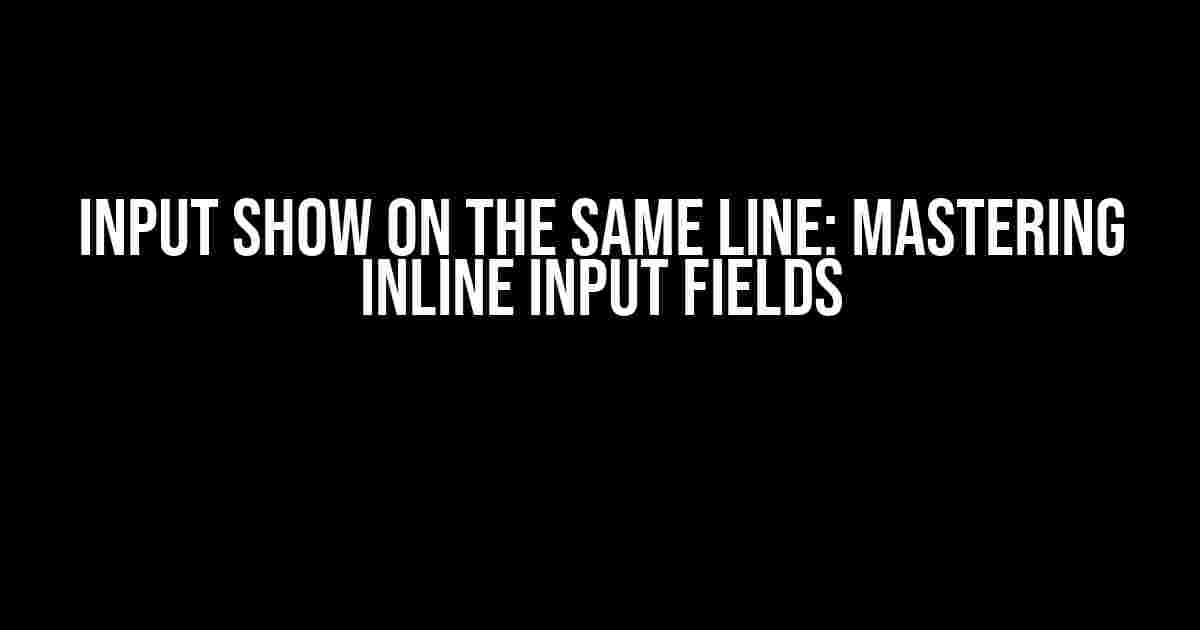In the world of web development, creating user-friendly and visually appealing interfaces is crucial. One often-overlooked aspect of UI design is input fields. Specifically, having input show on the same line can greatly enhance the user experience. In this comprehensive guide, we’ll delve into the world of inline input fields, exploring the benefits, techniques, and best practices for mastering this essential design element.
Why Input Show on the Same Line Matters
So, why is it important to have input show on the same line? There are several compelling reasons:
- Improved User Experience**: Inline input fields reduce clutter, making it easier for users to focus on the task at hand. By keeping related elements on the same line, you create a more streamlined and intuitive interface.
- Increased Conversion Rates**: By reducing visual noise, you can guide users more effectively through your form or survey, leading to higher conversion rates and better engagement.
- Enhanced Accessibility**: Inline input fields can be particularly beneficial for users with disabilities, as they provide a clear and consistent layout that’s easier to navigate.
Techniques for Input Show on the Same Line
Now that we’ve established the importance of inline input fields, let’s dive into the various techniques for achieving this design element:
Method 1: Using CSS Display Property
input, label {
display: inline;
}
This method is straightforward and effective. By setting the `display` property to `inline` for both the input field and its corresponding label, you can place them on the same line.
Method 2: Floating Elements
label {
float: left;
margin-right: 10px;
}
input {
float: left;
}
Another approach is to use the `float` property to position the label and input field adjacent to each other. This technique requires some margin adjustments to ensure proper spacing.
Method 3: Flexbox
div.input-container {
display: flex;
align-items: center;
}
label {
margin-right: 10px;
}
input {
flex-grow: 1;
}
Flexbox provides a powerful and flexible (pun intended) way to create inline input fields. By setting the container to `display: flex` and adjusting the `align-items` property, you can achieve a beautifully laid-out form.
Best Practices for Input Show on the Same Line
Now that we’ve covered the techniques, let’s explore some essential best practices to keep in mind when designing inline input fields:
- Consistency is Key**: Ensure that all inline input fields within your form or application follow the same design pattern. This consistency will create a sense of harmony and make your interface more intuitive.
- Label Placement**: Place labels to the left or right of the input field, depending on your design requirements. However, make sure to maintain a consistent label placement throughout your interface.
- Spacing and Margins**: Adjust margins and spacing between input fields and labels to create a visually appealing and well-balanced layout.
- Accessibility**: Don’t forget to ensure that your inline input fields are accessible to all users. This includes providing alternative text for screen readers and ensuring that the tab order makes sense.
Real-World Examples and Use Cases
Inline input fields can be used in a variety of scenarios, including:
| Use Case | Example |
|---|---|
| Search Bars | |
| Login Forms | |
| Surveys and Questionnaires |
These examples demonstrate how inline input fields can be used to create more user-friendly and visually appealing interfaces.
Conclusion
In conclusion, having input show on the same line is a crucial aspect of UI design that can greatly enhance the user experience. By mastering the techniques and best practices outlined in this guide, you’ll be well on your way to creating more intuitive and engaging interfaces. Remember to prioritize consistency, accessibility, and visual appeal when designing your inline input fields.
So, go ahead and take your web development skills to the next level by incorporating inline input fields into your projects. Your users will thank you!
Frequently Asked Question
Get the scoop on input fields showing on the same line – we’ve got the answers you need!
Why do I want to show input fields on the same line?
Showing input fields on the same line can improve the user experience by making it easier to scan and fill out forms, especially on mobile devices where screen real estate is limited. It also helps to reduce clutter and makes your form look more organized and modern.
How do I show input fields on the same line using HTML and CSS?
You can use CSS to achieve this by setting the display property of the input fields to “inline-block” and adjusting the width and margin properties to fit your needs. For example: input { display: inline-block; width: 30%; margin: 0 10px; }
Can I use Bootstrap or another framework to show input fields on the same line?
Yes, you can use Bootstrap’s grid system or other frameworks like Foundation or Bulma to show input fields on the same line. For example, in Bootstrap, you can use the “form-inline” class on the form element and the “form-control” class on the input fields.
How do I ensure input fields on the same line are accessible?
To ensure accessibility, make sure to provide a clear and consistent layout, use proper labeling and focus states, and test your form with assistive technologies like screen readers. You should also ensure that the input fields can be accessed using a keyboard and that the tab order is logical.
Are there any limitations or caveats to showing input fields on the same line?
Yes, there are some limitations to consider. For example, very long input fields may not fit on the same line, and some users may find it difficult to scan and fill out forms with multiple input fields on the same line. Additionally, you should ensure that the input fields are properly spaced and have sufficient padding to avoid visual clutter.
